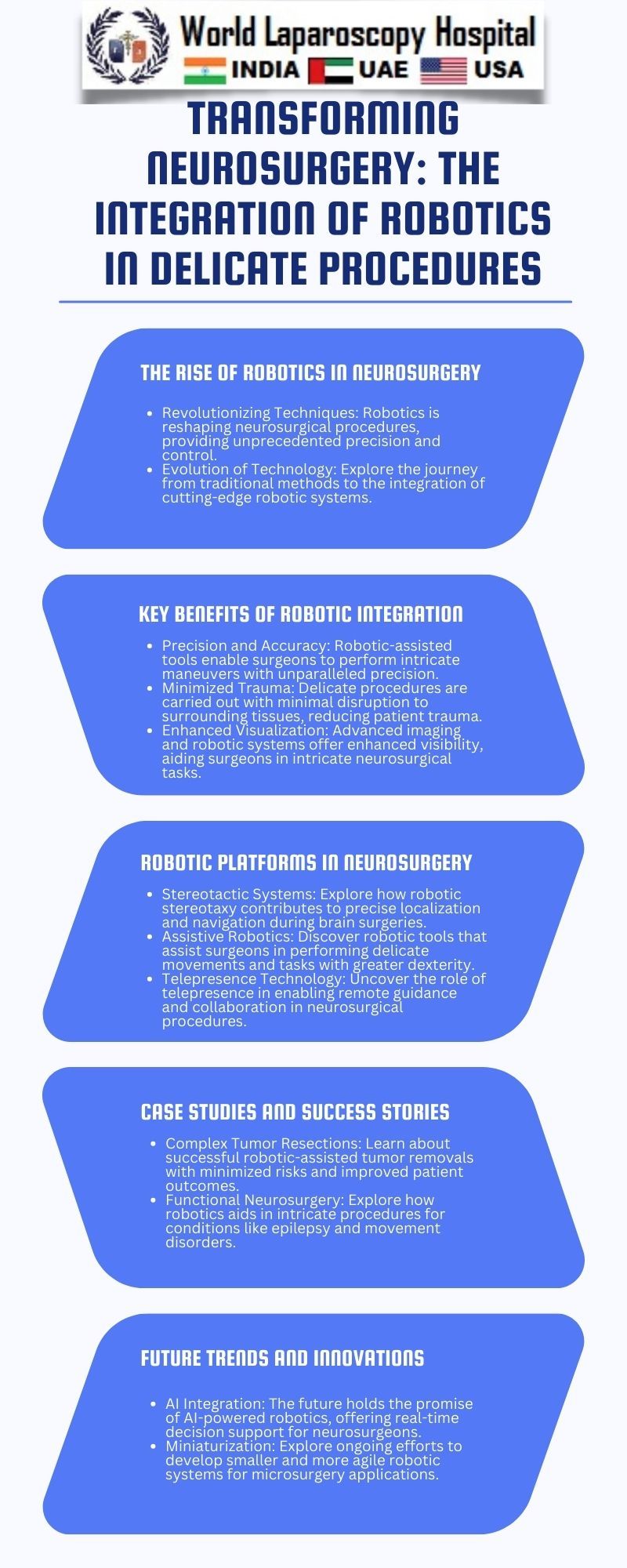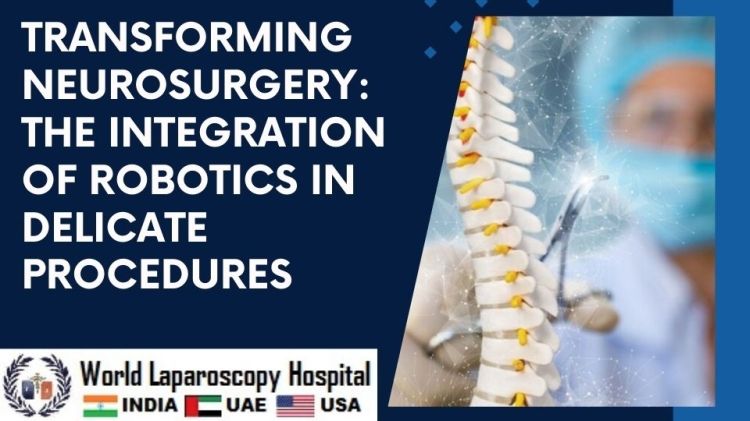Transforming Neurosurgery: The Integration of Robotics in Delicate Procedures
Introduction:
Neurosurgery, the medical discipline dedicated to treating disorders of the nervous system, has witnessed a revolutionary transformation with the integration of robotics into delicate procedures. As technological advancements continue to reshape the landscape of healthcare, the convergence of robotics and neurosurgery stands out as a pioneering development. This article explores the multifaceted impact of robotics on neurosurgical practices, delving into the evolution, current applications, challenges, and the promising future of this transformative integration.

Evolution of Robotics in Neurosurgery:
Historical Context:
The integration of robotics in neurosurgery has roots in the late 20th century, marked by the development of robotic systems for medical applications. Initial forays into robotics primarily focused on enhancing surgical precision and overcoming human limitations in delicate procedures. The da Vinci Surgical System, initially designed for minimally invasive procedures in other surgical specialties, paved the way for robotic assistance in neurosurgery.
Early Challenges and Milestones:
Early attempts to introduce robotics into neurosurgery faced challenges such as size constraints, limited dexterity, and the need for specialized training. However, milestones like the NeuroMate system in the early 1990s demonstrated the feasibility of robotic assistance in stereotactic neurosurgery. These pioneering efforts laid the foundation for subsequent innovations, pushing the boundaries of what was possible in the field.
Current Applications of Robotics in Neurosurgery:
Stereotactic Procedures:
Robotics has significantly advanced stereotactic procedures, enabling precise targeting in interventions like deep brain stimulation (DBS) for movement disorders and brain biopsies. The integration of robotics allows for submillimeter accuracy, reducing the invasiveness of procedures and minimizing the risk of damage to surrounding healthy tissue.
Cranial and Spinal Surgeries:
Robotic systems have found applications in cranial and spinal surgeries, where precision is paramount. In cranial surgeries, robots assist in tumor resections, aneurysm repairs, and intricate procedures in challenging anatomical locations. In spinal surgeries, robots aid in precise pedicle screw placement, enhancing the safety and efficacy of spinal fusion procedures.
Telesurgery and Remote Assistance:
The convergence of robotics and telemedicine has opened new frontiers in neurosurgery. Remote robotic assistance allows experienced neurosurgeons to guide and collaborate with their peers in different locations, expanding access to specialized expertise. This has proven particularly valuable in situations where immediate intervention is crucial, such as trauma cases or emergencies.
Advantages of Robotic Integration:
Precision and Accuracy:
One of the primary advantages of integrating robotics into neurosurgery is the unparalleled precision and accuracy it offers. Robotic systems can navigate intricate anatomical structures with submillimeter precision, minimizing the risk of errors and improving overall surgical outcomes.
Enhanced Visualization:
Robotic platforms often incorporate advanced imaging technologies, providing neurosurgeons with real-time, high-resolution visuals of the surgical site. This enhanced visualization aids in meticulous planning and execution of procedures, allowing surgeons to navigate complex anatomies more confidently.
Minimally Invasive Approaches:
Many robotic systems facilitate minimally invasive approaches, reducing the need for extensive incisions. This not only accelerates patient recovery but also lowers the risk of postoperative complications. The combination of robotics and minimally invasive techniques represents a paradigm shift in neurosurgical practices.
Surgeon Ergonomics:
Robotic systems are designed to enhance surgeon ergonomics by offering comfortable and intuitive interfaces. This ensures that neurosurgeons can maintain optimal focus and control throughout lengthy procedures, ultimately contributing to improved overall surgical performance.
Challenges and Considerations:
Cost and Accessibility:
While the benefits of robotic integration in neurosurgery are evident, the associated costs pose a significant challenge. The acquisition and maintenance expenses of robotic systems can be substantial, limiting their accessibility to larger medical centers. Addressing cost-related concerns is crucial for widespread adoption and equitable access to this technology.
Training and Learning Curve:
The proficiency required to operate robotic systems in neurosurgery demands specialized training. Neurosurgeons must undergo extensive learning curves to master the intricacies of these technologies. Establishing comprehensive training programs is essential to ensure the effective and safe utilization of robotic platforms.
Ethical and Legal Considerations:
The introduction of robotics in neurosurgery raises ethical and legal questions, particularly concerning issues of accountability and liability in the event of malfunctions or adverse outcomes. Clear guidelines and regulations must be established to govern the ethical use of robotic technology in neurosurgical practices.
Future Prospects and Innovations:
Artificial Intelligence Integration:
The synergy of robotics and artificial intelligence (AI) holds immense promise for the future of neurosurgery. AI algorithms can augment robotic systems, providing real-time decision support and enhancing surgical precision. This collaboration between robotics and AI is poised to elevate neurosurgical capabilities to unprecedented levels.
Miniaturization and Portability:
Ongoing efforts in miniaturization and portability aim to make robotic systems more versatile and accessible. Smaller, more portable robotic platforms could potentially extend the benefits of robotic assistance to a broader range of healthcare settings, including remote and underserved areas.
Haptic Feedback and Sensory Enhancement:
The integration of haptic feedback systems aims to replicate the sense of touch for surgeons operating with robotic assistance. Enhancing sensory feedback could further bridge the gap between traditional manual procedures and robotic interventions, allowing for a more intuitive and immersive surgical experience.
Conclusion:
The integration of robotics in neurosurgery represents a transformative leap forward, redefining the possibilities of delicate procedures within the realm of the nervous system. As technology continues to evolve, overcoming current challenges and addressing ethical considerations will be pivotal in realizing the full potential of robotic assistance in neurosurgical practices. With ongoing innovations and a commitment to accessibility, the future holds the promise of even greater precision, improved patient outcomes, and a continued revolution in the field of neurosurgery.


